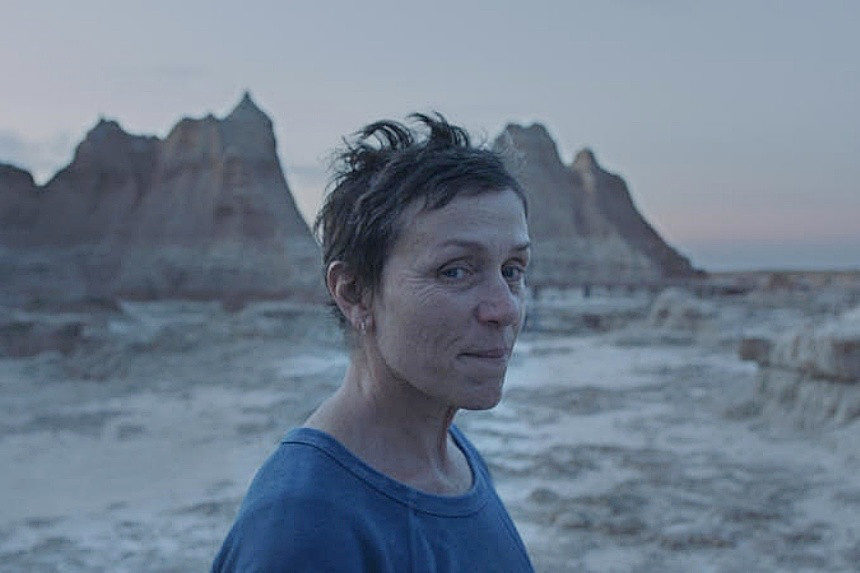Nomadland
⭐ ⭐ ⭐ ⭐ ⭐
Rating: R
Run Time: 1 hour 48 minutes
Stars: Frances McDormand, David Strathairn, Linda May, Charlene Swankie
Writer/Director: Chloé Zhao (Based on the book by Jessica Bruder)
In Theaters
Reviewed at the Toronto International Film Festival
A Grapes of Wrath for the 2020s, writer/director Chloé Zhao’s Nomadland offers a strikingly intimate portrait of a woman picking her way through the harsh — yet surprisingly rich — subculture of older American transient workers. The film never seeks sympathy for its hardscrabble subjects; instead, it embraces the human yearning for something more than mere survival, finding beauty in the mundane; heroism in the day-to-day.
Fern (Frances McDormand, Oscar-nomination bound once more) thought she was living the American dream. She and her husband both had good jobs with a Nevada sheet rock company; they lived in a comfortable company-owned house in a tight-knit company town. But cheap foreign imports and a building crash ran the firm out of business — and turned the community into a ghost town almost overnight.
Now Fern, unable to make ends meet on Social Security alone, lives in her trusty old van — she calls it Van Halen — following the seasons across the American West. In winter she’s down south as a seasonal employee at an Amazon fulfillment warehouse; in summer she heads north to the Dakotas, flipping burgers at Wall Drug Store or picking up trash at Badlands National Monument. Around her orbits a constellation of fellow graying nomads: Linda, a self-reliant extrovert; Swankie, whose skull-and-crossbones van decor is emblematic of the fact that she’s dying of cancer; and Dave (David Strathairn), a charming wanderer who seeks a way to Fern’s heart but finds the path barricaded with stubborn self-reliance and undefined sadness.
With meticulous compassion, director Zhao follows Fern on her yearly migration, bearing witness to the daily rituals that define her life: quietly eating canned soup, enduring a stomach virus alone in her van, awakening to the pounding of a security guard on her windshield, telling her to move on. As Fern, McDormand — who seems to do more with less each time we find her onscreen these days — is transparent in her contented solitude yet inscrutable in her ultimate aim. Surely, we think, Fern can see that the inevitability of age and infirmity will one day catch up to her. Why does she refuse the relative security of a relationship with Dave…or an open invitation to stay with her comfortably middle-class sister? As a former teacher, why does she not find some way to put that skill set to work? These questions frustrate us, for sure, but the masterful McDormand brushes them aside with wordless dismissiveness, inviting us instead to intimately partake in Fern’s compelling, world-weary voyage to nowhere.
As always, Strathairn is a joy to watch. His Dave is almost as elusive a character as Fern. We never really learn his back story, but at least he seems to be working toward another chapter, unlike so many of his fellow nomads who have convinced themselves they are riding not on a conveyor belt toward oblivion, but instead a carousel of acceptable, if not exciting, expectations.
The authenticity of Nomadland’s universe is heightened by director Zhao’s decision to cast genuine modern nomads to play themselves. Swankie and Linda are just a couple of the real people playing somewhat fictionalized versions of themselves; the trailer camps that Fern wanders through in Zhao’s mesmerizing tracking shots are the real thing; the stories these people tell are reflections of their genuine existence.
But if Nomadland bears the marks of real lives being lived before our eyes, Zhao’s lush cinematic vision serves as a constant reminder that we are in the hands of a master filmmaker. Shooting most often in the purples of dusk, Zhao and her frequent cinematographer Joshua James Richards evoke the boundless skies and endless horizons of America’s West while preserving the intimacy of the film’s personal portraits. Their collaboration not only evokes the visual language of John Ford and Terrence Malick, it stands beside those directors’ very best work.
In fact, you could well draw a line directly from the westerns of Ford to Nomadland — not Ford’s brawling, boastful westerns like She Wore a Yellow Ribbon and Fort Apache, but his reflective, uncertain works like The Searchers and The Man Who Shot Liberty Valance.
Ford, who also directed the screen version of The Grapes of Wrath, knew that the promise of the West was strewn with the wreckage of human folly and frailty. In Nomadland, Chloé Zhao replaces the wagon train with a procession of gas-guzzling old campers — and reminds us the human instinct for The Quest remains unabated…even when we can’t quite pinpoint what it is we’re questing for.
Featured image: Frances McDormand in Nomadland (Courtesy of Searchlight Pictures)
Become a Saturday Evening Post member and enjoy unlimited access. Subscribe now



